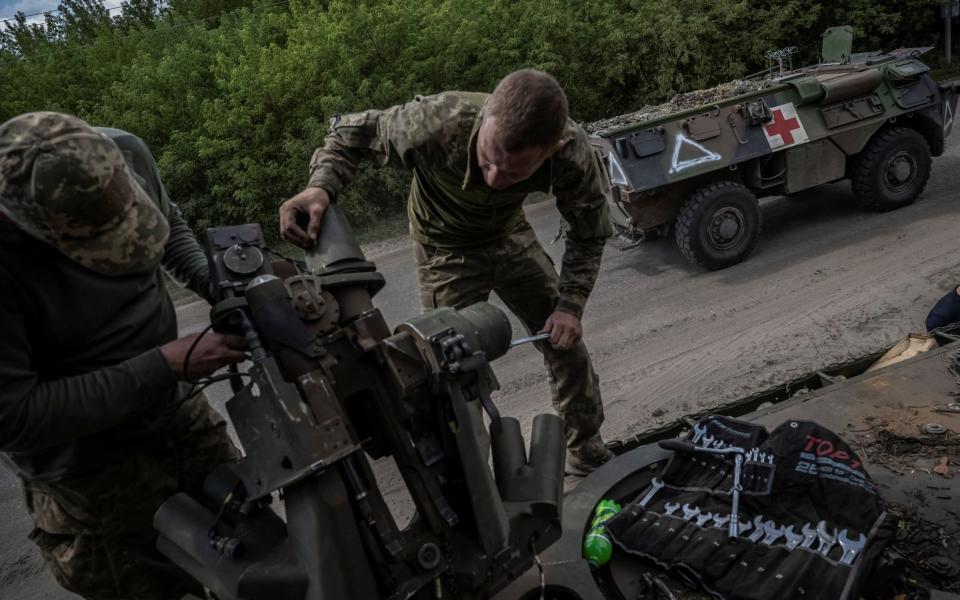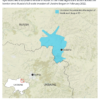As Ukrainian armoured vehicles maraud around the Russian countryside, they all sport the same symbol – a white triangle.
Tanks, trucks and Nato military equipment bearing the marking, daubed in paint or stuck on with tape, have forced the evacuation of some 180,000 Russian citizens from their homes.
It has been enough for some to brand the first invasion of Russian soil since the Second World War “operation triangle”.
In Ukraine’s Sumy region, a T64 tank with a triangle on its frontal armour was seen edging down a dirt road near the border.
Click here to view this content.
More than 13 miles inside Russia, near the town of Cherkasskoe Porechnoe, a tank and other armoured vehicles carried the mark.
And when Ukrainian troops drove into the village of Guevo to replace the Russian flag with their own, they drove in on a pickup truck carrying the white triangle.
Click here to view this content.
The battle marking was first spotted in June, being used by the Operational Command West group of forces stationed near the border with Belarus.
Ukrainian sources say the tactical marking is no more than a way for Kyiv’s forces to avoid friendly fire as they operate behind enemy lines in a chaotic, fast-paced mission.
Markers such as the triangle are a common part of modern warfare, especially when both sides use much of the same equipment and wear similar uniforms. Ukrainian forces will strap yellow or blue bands made from gaffer tape over their fatigues and helmets.
Click here to view this content.
When Russian tanks and armoured vehicles invaded Ukraine in February 2022, many were daubed with “Z” symbols in white paint – a marking that, back in Russia, has become synonymous with support for Vladimir Putin’s war.
Kyiv’s incursion into Kursk entered its seventh day on Monday. Panic spread to the Belgorod region, and its governor announced that residents of the Krasnaya Yaruga district, located on the frontier with Ukraine, would be evacuated because of military activity.
Belgorod neighbours the Kursk region, where Ukrainian forces began their cross-border raid on August 6.
On Monday, Tass, the state news agency, reported that 11,000 people had been evacuated. “It has been an alarming morning,” said Vyacheslav Gladkov, the Belgorod governor. “[There has been] enemy activity on the border of Krasnaya Yaruga district.”
Mr Gladkov said Russian soldiers would be able to “cope with the threat that has arisen”, but added: “In order to protect the lives and health of our population, we are starting to move people who live in Krasnaya Yaruga district to safer places.”
Click here to view this content.
Russian sources said Ukrainian troops launched an attack on the Kolotilovka checkpoint, a border crossing between Belgorod and Ukraine’s Sumy region, in the early hours of Monday.
It was claimed that Ukrainian troops, using armoured vehicles, tanks and artillery, opened fire at the checkpoint.
Ukrainian reserves are waiting at the rear, near the village of Pokrovka, prepared to join the fight as a second echelon force if a breakthrough is made.
“Apparently, the Ukrainian armed forces are not abandoning their plans to stretch our defensive lines, create the maximum number of points of tension and attempt to break through to the east with the aim of cutting off Belgorod from the north,” Rybar, an authoritative Russian military blogger, wrote on the Telegram messaging app.
The fighting in Kolotilovka is about 25 miles south of Sudzha, where Ukrainian forces have been advancing since last Tuesday as part of the surprise cross-border raid.
Alexi Smirnov, Kursk’s regional governor, told Putin on Monday that Kyiv controlled 28 villages and towns in the region. The area controlled was 7.5 miles deep and 25 miles wide, he said.
Twelve civilians had died and at least 121 others had been injured since the fighting broke out, he told the Russian president.
“As of today, 121,000 people have left and been evacuated,” the official said, adding that 59,000 more needed to leave the area. On Monday, Russian authorities were preparing “safe zones” for the Kursk residents displaced by the fighting.
A regional taskforce was set up to assist residents of the Belovsky district, part of Kursk south-east of Sudzha, to evacuate the area.
In recent days, Russia has been bringing in reserves in the hope of quashing the incursion, but on Sunday its military conceded that Ukraine had advanced 20 miles into Russian territory in some places.
On Monday, Ukraine’s army chief said his forces had captured around 1,000 square kilometres in total.
Click here to view this content.
The Institute for the Study War (ISW), a US-based think tank, said many Russian response forces had been hastily assembled and included units that were poorly prepared to stage a fightback.
Ukrainian troops equipped with top-end night vision goggles have staged several raids under cover of darkness, taking advantage of their technological superiority.
Battlefield footage geolocated by ISW analysts showed that they had made westward and northwestward gains, in areas where Russian sources had claimed the situation had been stabilised.
Russia’s defence ministry claimed on Monday that it had killed 260 Ukrainian troops and destroyed 31 armoured vehicles, including a tank and eight US-made Bradley fighting vehicles.
The ministry said its forces were “continuing to beat back the attempt by Ukraine’s armed forces to invade Russian territory”. However, it did not claim to have liberated any of the land lost in the Ukrainian advance.

In Ukraine, the battle has provoked rare joy among a population increasingly beaten down by war.
Emile Kastehelmi, an open-source intelligence analyst, said: “The best case scenario for Ukraine would probably be the following – Russia decides it’s not acceptable to leave any areas to Ukrainian hands, and will divert significant resources even from the most critical places and to get every square kilometre back, despite the losses.
“This would severely attrite the Russians, ease the pressure in other directions, and maybe even make it possible for Ukrainians to improve the tactical situation locally in the east.
“Regardless of whether the Ukrainians continue their advance, they have proved that occupation of relatively large areas is no longer a privilege of Russia. The war is now even more concretely a war on Russian soil as well.”
EMEA Tribune is not involved in this news article, it is taken from our partners and or from the News Agencies. Copyright and Credit go to the News Agencies, email news@emeatribune.com Follow our WhatsApp verified Channel





